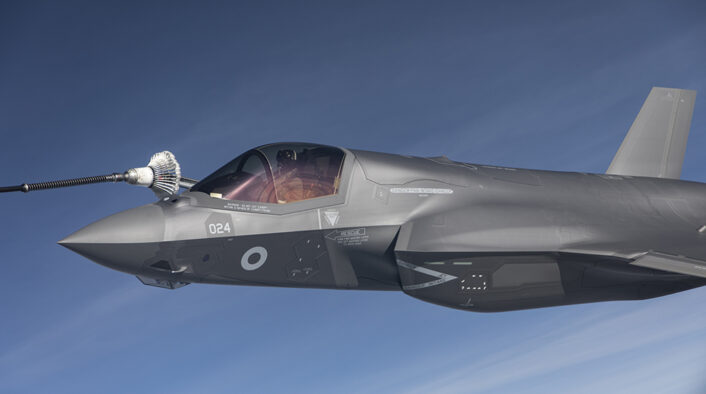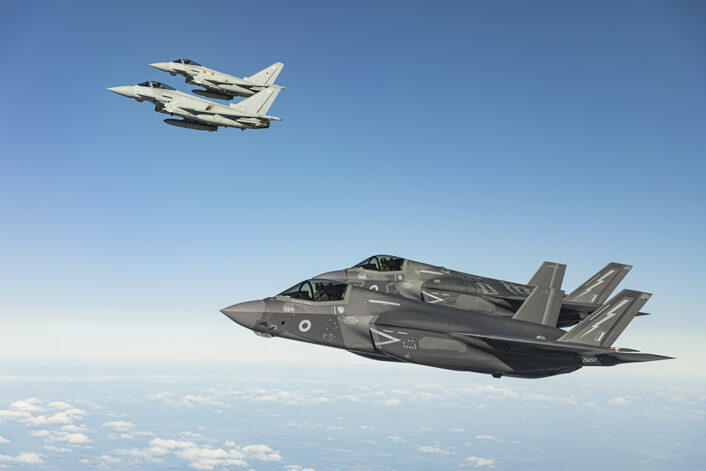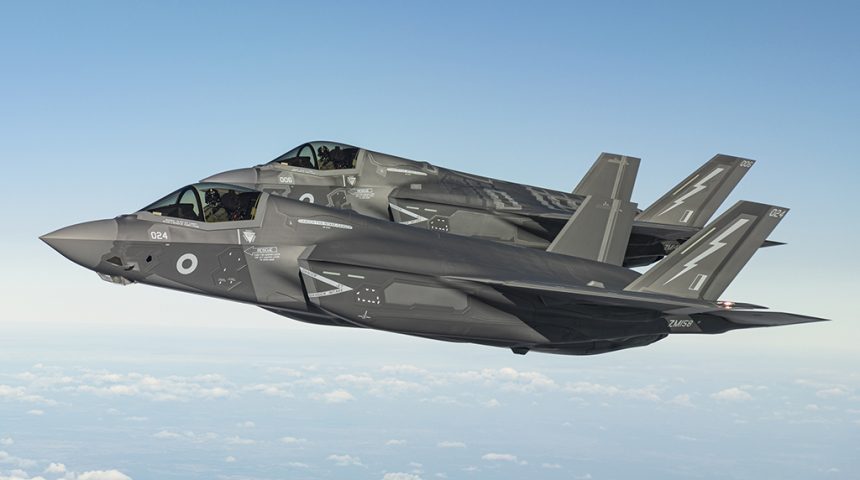The British F-35B stealth aircraft have joined Enhanced Vigilance Activity, the NATO-led mission launched as a consequence of the Ukrainian crisis.
The F-35B Lightnings of the Royal Air Force’s 617 Squadron from RAF Marham, have started flying armed patrols as part of the pre-planned Enhanced Vigilance Activity, which is a NATO led Operation initiated due to the unfolding events in Ukraine. The British 5th generation aircraft joined the RAF Typhoon FGR4 jets, flying from both RAF Coningsby in Lincolnshire and RAF Akrotiri in Cyprus, and the rest of the NATO assets that have been dispatched to the region following the Russian invasion of Ukraine.
The RAF F-35Bs have flown their first mission over Eastern Europe on Mar. 3, 2022, the Royal Air Force has announced on their public website.

The aircraft were supported by RAF Voyager Air-to-air refuelling aircraft from RAF Brize Norton.
“The F-35 is an incredibly capable and versatile aircraft. Operating alongside the Typhoons to maintain the integrity of the European airspace and contribute to the NATO Mission, the 5th Generation Fighter is a world beating fighter aircraft which can simultaneously provide Information Warfare, Intelligence gathering and Air-to-Air missions,” said Station Commander RAF Marham.
Interestingly, unlike the two F-35As of the U.S. Air Force, which operated without radar reflectors/Radar Cross Section (RCS) enhancers over Poland on Feb. 28, 2022, the British F-35Bs, at least on the mission depicted by the photos released by the Royal Air Force, were mounting their radar reflectors (hence they were not in “full stealth mode”).
The “Dambusters” of 617 Sqn fly the F-35B STOVL (Short Take Off Vertical Landing) variant of the Joint Strike Fighter. In 2019, the unit deployed six aircraft to RAF Akrotiri, as part of Operation “Lightning Dawn”, the Squadron’s first overseas deployment. From there, on Jun. 16, 2019, the British F-35Bs (with internal Paveway IV bombs and AIM-120 AMRAAM air-to-air missiles, along with RCS enhancers) launched their first sorties in support of Operation Shader, the UK contribution to the Global Coalition’s counter Daesh mission in Iraq and Syria, making the Royal Air Force the fourth air arm (after the Israeli Air Force, the U.S. Marine Corps and the U.S. Air Force) to carry out combat missions with the F-35 Joint Strike Fighter. The F-35Bs of the 617 Sqn have flown sorties in support of Shader flying from HMS Queen Elizabeth (HMSQE) again in June 2021, during CSG-21, HMSQE’s maiden cruise.

To that respect, the RAF’s F-35Bs have already conducted land-based overwatch patrols like those the stealth jets are flying along NATO’s Eastern Flank these days. While we have no details about the type of armament the aircraft are flying in support of Enhanced Vigilance Activity it seems quite reasonable, considered the current posture, that they are operating with AAMs (Air-to-Air Missiles). Anyway, as explained reporting about the mission over Eastern Europe an F-35 flew from Germany, one of the most valuable features that makes the F-35 so important especially when fighting against high-threat enemies inside or near contested airspace is its ability to use its AESA radar and onboard sensors to collect electronic signals emitted by enemy radars, to identify, classify, geolocate them, display them to the pilot and then share the collected data with other F-35s via MADL (Multifunction Advanced Data Link) or to 4th generation aircraft via Link 16. In other words, the Lightning can contribute along with more traditional ISR (Intelligence Surveillance Reconnaissance) platforms to build the enemy EOB (Electronic Order of Battle) and distribute the intelligence it gathered providing “kinetic situational awareness” to other previous generation aircraft.
So, the flight hours spent by U.S., UK and Dutch F-35s inside NATO airspace near the borders with Ukraine will probably be particularly useful to collect a lot of intelligence about the Russian “hardware” used in Ukraine.









